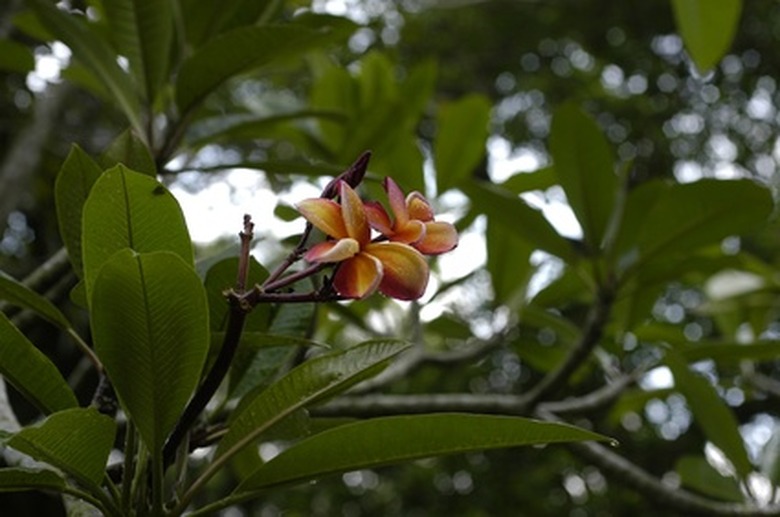Tropical Plants In Singapore
Singapore's 277 square miles are home to more than 2,000 native plant species, all of which have adapted to life in a tropical climate a short distance north of the Equator. Daytime temperatures regularly reach 85 to 90 degrees F, dropping to about 80 at night. Singapore's plants also cope with high humidity and rainfall. Even with those challenges, they perform well enough to earn Singapore its international reputation as a Garden City.
Mahoe
Mahoe (Hibiscus tiliaceus) is an ornamental tropical tree native to Singapore. Also known as sea hibiscus, mahoe stands between 26 and 32 feet tall and can get just as wide. Common in Singapore's mangrove swamps and along waterways, wild mahoe often forms large, dense thickets. Native mahoe has heavy, heart-shaped dark green leaves. Its four- to six-inch, funnel-shaped flowers are vivid yellow with deep crimson stamens. Although they usually live only 24 hours, they change from yellow to orange before they fall from the trees. Plant mahoe in moist, sandy soil, advises the Hibiscus.org website. Highly tolerant of salt spray, it's an excellent choice for coastal gardens.
- Singapore's 277 square miles are home to more than 2,000 native plant species, all of which have adapted to life in a tropical climate a short distance north of the Equator.
- Common in Singapore's mangrove swamps and along waterways, wild mahoe often forms large, dense thickets.
Trumpet Tree
A tropical native of Mexico and Central America, trumpet tree (Tabebuia rosea) stands 60 to 80 feet tall. A rapid grower, it has white or pink, trumpet shaped flowers. The April and August blooms cover the trees following dry periods. After dropping from the trees, the flowers carpet the ground with color for two or three more days. Trumpet trees produce long, flat seedpods that release the wing seeds by which the trees spread. Trumpet tree, according to World Agroforestry, needs rich, deep soil.
Yellow Bells
Yellow bells (Tecoma stans), an evergreen tropical shrub native to South America, is a Singapore favorite thanks to the abundant yellow flowers adorning it several times a year. The fragrant, bell-like blooms appear during each of the shrub's frequent growth spurts, say Edward F. Gilman and Dennis G. Watson, professors at the University of Florida. Standing 20 to 30 feet high and wide, yellow bells has four-to-eight-inch, lance-shaped green leaves. Drooping branches require pruning in highly trafficked areas. A drought-tolerant tree, it prefers full sun. Plant in well-drained clay, sand or loam. It handles both alkaline and acidic soils.
- A tropical native of Mexico and Central America, trumpet tree (Tabebuia rosea) stands 60 to 80 feet tall.
- Drooping branches require pruning in highly trafficked areas.
Cape Honeysuckle
Cape honeysuckle (Tecomaria capensis), a mounding tropical shrub-or a vine if given proper support-is native to South Africa. Planted as a vine, it will grow between 20 and 30 feet, according to the University of Arizona. Cape honeysuckle has dark green glossy leaves and trumpet-shaped orange or red-orange flowers. It blooms at different times through the year, with heaviest flowering occurring between November and January. Hummingbirds flock to this plant. Use it as a three- to five-foot high hedge or foundation planting as well as a vine. Heat -and-drought-tolerant, it grows well in full sun to partial shade and well-drained soil. Water it deeply once a week.
- Cape honeysuckle (Tecomaria capensis), a mounding tropical shrub-or a vine if given proper support-is native to South Africa.
- Use it as a three- to five-foot high hedge or foundation planting as well as a vine.
